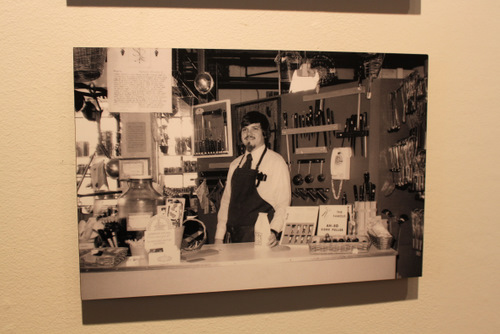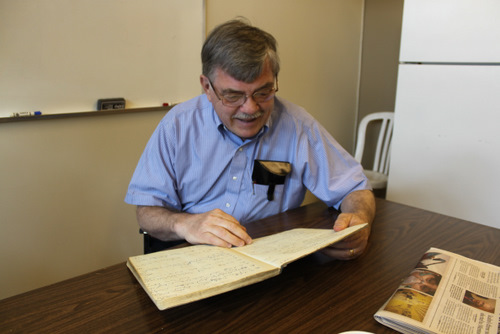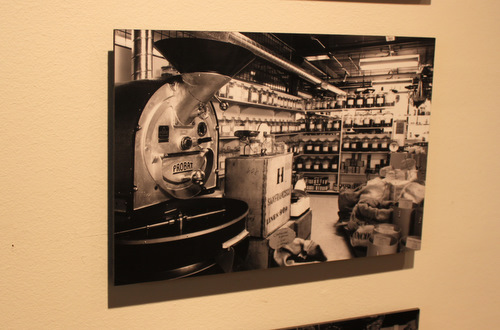[Part 1 of this history can be found here]
Originally from Massachusetts, David Kobos spent many of his years growing up in New York. The pursuit of higher education eventually led him out West, and he spent four years getting a master’s degree from Reed College. After graduating, he taught in Milwaukie for a couple years. During this time, Kobos used to stop in and get coffee from Boyd’s Little Red Wagon.
“That's how I got started drinking real coffee," he said.
After his time in Milwaukie, Kobos moved back to New York, where he got a job as a teacher at a school in the Lower East Side (of Manhattan). In his free time, he began exploring restaurants in Chinatown and Little Italy, which were both nearby the school. He became fascinated with the city’s food and coffee culture and began visiting the shops of the Lower West Side too, where the Shapiro Brothers and the McNulty family were famous for roasting coffee.
At some point during his culinary explorations, Kobos met his future wife and got married. The couple went on a honeymoon to the Pacific Northwest and then returned to the Big Apple. Together, they really got into exploring restaurants. His wife was a good cook, he said, so they began to shop at higher-quality markets, trying to duplicate at home what they had been tasting in restaurants. The couple also drank plenty of coffee and visited all of New York’s famous cafés.
Kobos recalled some of the smells in the neighborhoods where the stores roasted their own coffee:
"There was this one little Italian roaster, down in Little Italy, who used to take one kind of coffee and just burn the hell out of it. You could smell it if you went anywhere near that place,” he said, laughing.
Eventually, the Kobos and his wife decided they needed a change of scenery. Remembering the beauty of the Pacific Northwest, they decided to move across the country to Portland, where they would indulge their love of food and coffee by starting a cookware and coffee retail store (and a family). It was a lot of change in a short amount of time, and their friends were skeptical.
“’You’re doing what?’—that’s what they asked us. They thought we were crazy,” Kobos said, recalling the reactions of his friends and family. “You’ve got a job already. Why would you want to do that?”
Undeterred, the couple moved forward with their plans. However, plans soon changed. The original plan was to ask Boyd’s Coffee to roast coffee beans for Kobos to sell in the store, but when David asked them, they turned him down. It was a pivotal moment for the Kobos story.
David soon got on the phone with a Probat salesman from New Jersey, Gilbert Holmberg, and ordered a Probat roaster from the East Coast. He found a small shop in John’s Landing and set it up in the front of the store, where he started roasting his own beans.
The orginal John's Landing store
"That's kind of how it was at Shapiro brothers and McNulty’s,” he recalled. “They had the roasters out in the store.”
Kobos said that the early days were nerve-racking times, but he never worried about learning the art of roasting. Bud Dominguez, father of Don Dominguez, who started Portland’s K&F Coffee, gave Kobos a roasting lesson one Saturday morning to get him started.
Even though Kobos’ roasting technique may have not been refined back then, his results were satisfactory.
“I never had any doubt that the product I was putting out was vastly superior to almost everything else that I was drinking,” he said.

What really worried Kobos was that he was roasting coffee in an old, three-story wood building. Roasting coffee required lots of heat, and there were plenty of things in the store that could catch fire.
As Kobos was talking about the early days, Dibble got up from his chair and disappeared for a few minutes. He came back with a well-worn blue notebook, Kobos’ original roasting log. He sat down at the table, flipping through the pages. At a pause in the conversation, he started reading out loud a passage that David Kobos had written in his roasting log many years before, after a particularly exciting day at the store.
"About 9:10, I discovered that I had let the temperature [in the roaster] get up to 250° Celsius. When I let some coffee out, it burst into flames. I called Ken [the shop clerk] over. By this time the coffee in the roaster had caught fire. Ken opened the door while I sprayed the coffee with CO2. I sprayed more into the chaff collector and thought the fire was out…Then the chaff collector burst into flames."
Kobos interjected, “This is right inside the shopping center, that was [built out of] wood.”
Dibble continued: "I sprayed it with powder. I thought that the fire had maybe gotten into the flu, so I called the security guard and went up to the roof to spray some down the flu while Ken called the fire department. The fire department arrived and I was still on the roof. I went back to the store and discovered that the chaff burner had burst into flames again."
The building was not damaged, but the incident made Kobos even more nervous. He got on the phone again and asked Gilbert Holmberg, who had sold him the roaster, about installing a fire suppression system. Holmberg informed him that do so would be cost-prohibitive. In what Kobos described as a “mellifluous, stentorian voice*,” he told Kobos that “vigilance, eternal vigilance is the only way [to be safe].”
Holmberg did send him something though. About four days later, Kobos received a package in the mail. He opened the package to find a Swedish 'kitchen witch' inside. It was a small figurine of a witch on a broom that the Swedes traditionally hang in their kitchens to prevent fires. Holmberg had sent him a cost-effective fire suppression system after all. Kobos hung it up over the roaster. It seemed to work just fine.
On a whim, Kobos decided to sell a few of the witches in his stores. They sold like gangbusters. He still marvels at how they resonated with customers.
“I kept ordering them and ordering them, and people just kept buying them,” he said, laughing heartily as he told the story. “We sold a thousand of them in the run-up to Christmas that year. I couldn’t believe it!”
Today, the original witch no longer hangs over the roaster, but Kobos does have it in his office, as a reminder of some of the memories of the past four decades.

When he first started, Kobos thought the business needed more than just coffee to survive, so in addition to the coffee beans, they sold tea, spices and cookware. It was a smart decision. Julia Child was on TV at that time, popularizing the gourmet food movement, so people were flocking to stores to buy new kitchen tools. Kobos and his wife seemed to have a good eye for what customers wanted, so they sold a lot of cookware. Over the last 15 years, larger stores such as Bed Bath & Beyond and Macy’s have really taken over the niche, making it hard or smaller retailers to compete. Today, a much smaller portion of the Kobos’ business is cookware, but they still sell some at the Vaughn Street store and online.
While selling cookware was a part of the original store, selling brewed coffee to customers was not. He used to just give them samples so that they would buy the beans. Kobos said that his friends back east kept telling him to sell coffee for customers to drink, but he wouldn't listen. He finally "saw the light" in the 1980s and bought an espresso machine. He was glad he did, because the industry took off in the 80s and 90s, with Starbucks leading the trend.
The conversation shifted to how Starbucks had really changed the industry. David Kobos knew Starbucks’ history fairly well. David used to get together with Jerry Baldwin and Zev Siegel, Starbucks’ original founders, to do training sessions. He is still friends with Siegel today.
When Schultz bought the company, Kobos could not have predicted how big Starbucks would get, but he did have a feeling that Howard Schultz would be successful. Kobos first met Schultz when Schultz was working for Hammarplast selling kitchenware.
“Howard Schultz is probably the most charismatic person I have ever met,” he said. “You could just sit there and listen to him. He had all these stories. [When Schultz first started to expand the company] I had so many people telling me he's crazy. He just spent a million dollars to build a test store just to train employees! The guy's out of his mind. He's going to lose everybody's money!’ Zev Siegel called me up and said 'you know there are fifty Starbucks stores now and there's going to be a hundred in a year?’”
Like many others I have talked to, both Kobos and Dibble agreed that Starbucks had been very influential in educating customers and teaching them that it was possible to have better coffee. Starbucks’ ambition has made it possible for many others to be successful in the coffee industry.
After hearing a couple more stories, it was time to for me to let Dibble and Kobos to get back to work. They had already been more generous with their time than I had expected. We wished each other well, and I left, in search of more coffee and more stories. I now understood why the Kobos café had so much kitchen gadgetry in it, and my understanding of Portland’s coffee history was a little more complete. Hopefully, if you made it this far, yours is too.
Kobos Website: www.kobos.com
*definitions (because we like words)
mellifluous – flowing sweetly like honey
stentorian – very loud, powerful
